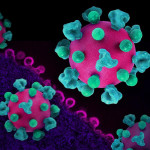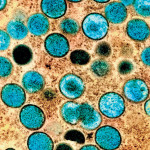When he found out he had HIV, artist Steven Wolf began putting his money away until he could quit his teaching job. Then he built a cabin in the woods outside Norfolk, Virginia and lived there for two years, painting in isolation from the world. What he produced is a tale of emotional survival told in oils.
One of his paintings from this period shows a nude male figure lying on the floor of a bare, unfurnished apartment and another man backing out of the room. “I was in denial and very depressed,” he recalls. “I was rejected by a number of men I was dating when I told them I had HIV. Pretty soon I just gave up on the whole idea of relationships. I went into retreat.”
During his “Blue” (as in Blue Ridge Mountains) Period, Wolf’s paintings took on a distinctive theme: A central male figure in repose, his body naked against the earth, surrounded by a series of rugged, stunningly beautiful landscapes. The figures seem to grow out of the earth itself, taking on the same deep gold and green hues as the mountains. Says Wolf, “I was desperately trying to hide from the reality of HIV.”
After two years, Wolf’s isolation began to gnaw at him, both emotionally and physically. “I had to get out of that hibernation state. I was shut off from the world; I wasn’t dealing with my illness. My T-cell count went down to 130, and I had no energy. When you get so low you feel there’s nothing to live for, you either let yourself die or stop being a victim and take control.”
Wolf opted for control. He packed up his canvases, sold the cabin and moved to town. Gradually, he became involved in the small arts community in Norfolk.
“People see me as a bit of an oddity around here,” Wolf admits. The environment is as socially conservative as it is physically beautiful. As much as he tried -- like the figures he painted -- to blend into the landscape, he ended up attracting attention. “Most gays and lesbians here are closeted, and most people with HIV aren’t out about their status.” Wolf was open about both. “I was never any good at being deceptive,” he laughs. His beguiling, easygoing manner drew people to him and helped melt the ice between him and the world. In the past eight years he’s become a community role model for other gay men, especially artists.
Wolf also took control of his health issues, becoming a self-described “exercise freak,” and taking up bio-feedback, meditation and yoga. In addition to strengthening his immune system, Wolf conquered his depression, and the success of his recovery sometimes surprises him. “I never thought of myself as the survivor type, one of those inspiring people who plows forward. I was always kind of a wimp.”
Wolf’s transformation is remarkably chronicled on canvas. Work from his post-cabin years features the same male nudes as central figures, but now they are soaring above the clouds, transfigured into ethereal beings. No longer earthbound, they have become godlike, heroic, mythical.
Wolf is careful to describe his work as semi-autobiographical. “The figures don’t so much represent me as what I was aspiring to.”
Wolf is now gearing up for the next challenge of his life: Moving to the Big City. “I’ve been thinking about Philadelphia for a couple of years. It’s the next step in coming out of isolation.” Once again, his current paintings tell the story through a more complex, urban theme: The floating figures are now coming up against block-like obstacles, trying to surmount concrete walls. Wolf says the impediments represent his new struggles with his physical and emotional health.
“If I hadn’t gotten HIV, I wouldn’t have stretched my art nearly as far as I have,” Wolf says. “Some people just need a challenge.”






Comments
Comments